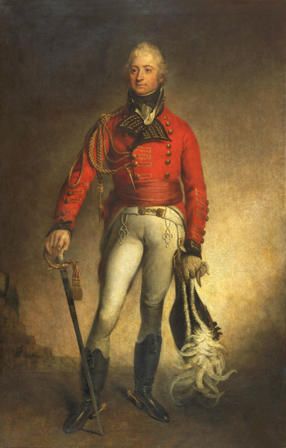Art Collections Online
Lieutenant-General Sir Thomas Picton (1758-1815)
SHEE, Sir Martin Archer (1769 - 1850)

Media: oil on canvas
Size: 214.0 x 137.1 cm
Acquired: 1907; Gift; Earl of Plymouth
Accession Number: NMW A 473
Thomas Picton – also known as the Tyrant of Trinidad, or the Blood-Stained Governor – is a controversial figure. Historically he has been hailed a public ‘hero’, but his governance of Trinidad and his treatment of slaves marks him out as a particularly cruel leader.
Picton’s reputation was built on his military prowess. He fought under the Duke of Wellington during the Peninsular War. Wellington described him as 'a rough foul-mouthed devil as ever lived, but he always behaved extremely well'. He rose to military success, and was the highest-ranking officer to be killed defending Britain in the Battle of Waterloo, 1815.
Very quickly after his death he was hailed a war hero. A monument was erected in his name at St Paul’s Cathedral ‘in honour of the splendid victory of Waterloo’, and many other public memorials followed. In Wales this included an obelisk in Carmarthen paid for by public subscription, and later a marble sculpture of Picton in the Heroes of Wales series at Cardiff City Hall. Picton, born in Haverfordwest in 1758 – was seen by many as a source of national pride.
But public memorials, though built to remember, are often designed to forget. And that which has been forgotten in the glorification of individuals like Thomas Picton is the violence and atrocities of our colonial past.
Picton, like many others, directly profited from slave trade activities. More than this, he was renowned for his ruthless treatment of slaves and others as the first British governor of Trinidad.
In 1803 he was brought to trial in London for authorising the torture of Louisa Calderon, a free 14 year old described as a ‘mulatto’ girl, who had been accused of theft. Louisa was hung from a scaffold by her wrist for almost an hour, her entire weight being supported on an upturned wooden peg – an excruciating form of torture known as picketing.
During the trial, Picton was also investigated for torturing, decapitating and burning alive slaves accused of sorcery, witchcraft and necromancy. His small military force used hangings and mutilations as a way of keeping control. He was convicted, but the verdict was later overturned, with Picton arguing that Trinidad at the time was under Spanish law, which sanctioned torture.
This full-length portrait of Picton in military uniform by Martin Archer Shee was given to the National Museum of Wales in the year of its foundation, 1907 and is therefore among the earliest group of paintings to enter the museum’s collection. It is believed to have been exhibited at the Royal Academy in 1816, a year after Picton’s death.
For a comprehensive account of the Louisa Calderon trial, and the role Thomas Picton played see James Epstein, ‘Politics of Colonial Sensation: The Trial of Thomas Picton and the Cause of Louisa Calderon’, American Historical Review (June 2007)
Comments - (1)